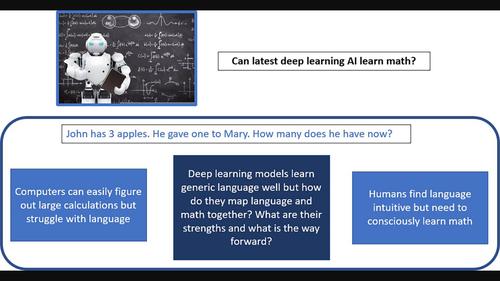当前位置:
X-MOL 学术
›
WIREs Data Mining Knowl. Discov.
›
论文详情
Our official English website, www.x-mol.net, welcomes your
feedback! (Note: you will need to create a separate account there.)
Does a language model “understand” high school math? A survey of deep learning based word problem solvers
WIREs Data Mining and Knowledge Discovery ( IF 6.4 ) Pub Date : 2024-03-25 , DOI: 10.1002/widm.1534 Sowmya S. Sundaram 1 , Sairam Gurajada 2 , Deepak Padmanabhan 3 , Savitha Sam Abraham 4 , Marco Fisichella 1
WIREs Data Mining and Knowledge Discovery ( IF 6.4 ) Pub Date : 2024-03-25 , DOI: 10.1002/widm.1534 Sowmya S. Sundaram 1 , Sairam Gurajada 2 , Deepak Padmanabhan 3 , Savitha Sam Abraham 4 , Marco Fisichella 1
Affiliation

|
From the latter half of the last decade, there has been a growing interest in developing algorithms for automatically solving mathematical word problems (MWP). It is a challenging and unique task that demands blending surface level text pattern recognition with mathematical reasoning. In spite of extensive research, we still have a lot to explore for building robust representations of elementary math word problems and effective solutions for the general task. In this paper, we critically examine the various models that have been developed for solving word problems, their pros and cons and the challenges ahead. In the last 2 years, a lot of deep learning models have recorded competing results on benchmark datasets, making a critical and conceptual analysis of literature highly useful at this juncture. We take a step back and analyze why, in spite of this abundance in scholarly interest, the predominantly used experiment and dataset designs continue to be a stumbling block. From the vantage point of having analyzed the literature closely, we also endeavor to provide a road‐map for future math word problem research.This article is categorized under: Technologies > Machine Learning Technologies > Artificial Intelligence Fundamental Concepts of Data and Knowledge > Knowledge Representation
中文翻译:

语言模型能“理解”高中数学吗?基于深度学习的应用题解决器调查
从上个十年的后半叶开始,人们对开发自动解决数学应用问题(MWP)的算法越来越感兴趣。这是一项具有挑战性且独特的任务,需要将表面级别的文本模式识别与数学推理相结合。尽管进行了广泛的研究,我们仍然有很多东西需要探索,以构建基本数学应用问题的稳健表示和一般任务的有效解决方案。在本文中,我们批判性地研究了为解决应用问题而开发的各种模型、它们的优缺点以及未来的挑战。在过去的两年里,许多深度学习模型在基准数据集上记录了相互竞争的结果,这使得对文献的批判性和概念性分析在此时非常有用。我们退后一步并分析为什么尽管学术兴趣如此丰富,但主要使用的实验和数据集设计仍然是绊脚石。从仔细分析文献的角度来看,我们还努力为未来的数学应用问题研究提供路线图。本文分类如下: 技术 > 机器学习 技术 > 人工智能 数据和知识的基本概念 > 知识表示
更新日期:2024-03-25
中文翻译:

语言模型能“理解”高中数学吗?基于深度学习的应用题解决器调查
从上个十年的后半叶开始,人们对开发自动解决数学应用问题(MWP)的算法越来越感兴趣。这是一项具有挑战性且独特的任务,需要将表面级别的文本模式识别与数学推理相结合。尽管进行了广泛的研究,我们仍然有很多东西需要探索,以构建基本数学应用问题的稳健表示和一般任务的有效解决方案。在本文中,我们批判性地研究了为解决应用问题而开发的各种模型、它们的优缺点以及未来的挑战。在过去的两年里,许多深度学习模型在基准数据集上记录了相互竞争的结果,这使得对文献的批判性和概念性分析在此时非常有用。我们退后一步并分析为什么尽管学术兴趣如此丰富,但主要使用的实验和数据集设计仍然是绊脚石。从仔细分析文献的角度来看,我们还努力为未来的数学应用问题研究提供路线图。本文分类如下:






























 京公网安备 11010802027423号
京公网安备 11010802027423号